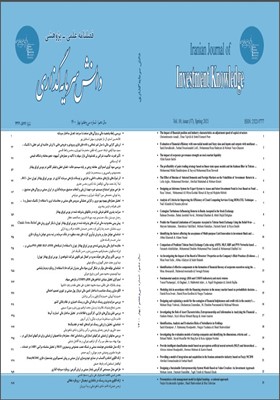الگوسازی ریسک متناسب با ساختارتامین مالی دربازارپول مبتنی برتئوری تصمیم احتمالی
محورهای موضوعی : دانش سرمایهگذاری
حمیدرضا ایروانی
1
,
حمیدرضا کردلوئی
2
*
![]() ,
نرگس یزدانیان
3
,
نرگس یزدانیان
3
1 - گروه حسابداری ومدیریت،دانشکده علوم تربیتی ومشاوره (مدیریت وحسابداری)،واحدرودهن،دانشگاه آزاداسلامی ،رودهن،ایران
2 - گروه مدیریت مالی،دانشکده مدیریت وحسابداری،واحداسلامشهر،دانشگاه آزاداسلامی ،اسلامشهر،ایران.(گروه پژوهشی مخاطرات مالی نوین)(نویسنده مسئول )
3 - گروه حسابداری ومدیریت ،دانشکده علوم تربیتی ومشاوره )مدیریت وحسابداری(،واحدرودهن،دانشگاه آزاداسلامی ،رودهن،ایران.
کلید واژه: واژگان کلیدی: ساختار تامین مالی, بازار پول, تئوری تصمیم احتمالی, ریسک سیستماتیک, ریسک نقد شوندگی,
چکیده مقاله :
ساختار مالی سازمانها یکی از موضوعات مهم در تئوریهای مدرن مالی میباشد که در سالهای اخیر مطرح نشده، بلکه کانون توجه محققین در چند دهه اخیر بوده است. منابع مختلف تأمین مالی، انجام سرمایهگذاری مطلوب را ممکن ساخته و میتوانند باعث افزایش ثروت سهامداران شود.. لذا با توجه به اهمیت ریسک ساختار تامین مالی هدف تحقیق حاضر الگو سازی ریسک متناسب با ساختار تامین مالی دربازار پول مبتنی بر تئوری تصمیم احتمالی است. این پژوهش از نظر روش پژوهش، در زمره پژوهش توصیفی تحلیلی از نوع سری های زمانی جای میگیرد. جامعه آماری پژوهش، خبرگان حوزه مدیریت مالی بانکها می باشد. در این پژوهش پس از مرور ادبیات مختلف در زمینه های ریسک های مالی و نسبت های مالی بانک ها، مهمترین ریسک ها شناسایی شد. برای جمع آوری داده ها ترکیبی از دو روش استفاده شد. به این صورت که با استفاده از روش کتابخانه ای ادبیات موضوع؛ چارچوب نظری و پیشینه مناسبی برای تحقیق فراهم شد و در مرحله دوم با جمع آوری نظرات خبرگان اقدام به مدلسازی کردیم. در این تحقیق بعد از جمع آوری اطلاعات از تکنیک Ahpاستفاده شد. نتایج نشان داد ریسک سیستماتیک از بیشترین اولویت برخوردار است.ریسک نقدینگی در اولویت دوم قرار دارد.ریسک توزیع درآمد در اولویت سوم ،ریسک عملیاتی در اولویت چهارم،ریسک سرمایه در اولویت پنجم، ریسک اعتباری در اولویت ششم وریسک بازار دراولویت هفتم وریسک رقابت دراولویت هشتم وریسک نقدشوندگی در اولویت آخر قرار دارد.
has not been raised in recent years, but has been the focus of researchers in recent decades. Different sources of financing make it possible to make the desired investment and can increase the wealth of shareholders. Therefore, considering the importance of risk in the financing structure, the purpose of this study is to model risk in accordance with the financing structure in the money market based on probabilistic decision theory. In terms of research method, this research is in the category of descriptive-analytical research of the time series type. The statistical population of the study is experts in the field of financial management of banks. In this study, after reviewing various literature in the fields of financial risks and financial ratios of banks, the most important risks were identified. A combination of two methods was used to collect data. By using the library method of the subject literature; A theoretical framework and background were provided for the research, and in the second stage, we modeled by collecting the opinions of experts. In this study, after collecting information, Ahp technique was used. The results showed that systematic risk has the highest priority. Liquidity risk is in the second priority. Income distribution risk in the third priority, operational risk in the fourth priority, capital risk in the fifth priority, credit risk in the sixth priority,Market risk in the seventh priority,Competition risk in the Eighth priority andMarket liquidity risk in the last priority. has it.
* جلیلوند، ابوالحسن؛ رستمی نوروزآباد، مجتبی؛ عسکری فیروزجایی، احسان؛ رحمانیانی، میلاد.(1398). یازده سازی مدیریت ریسک سازمانی؛ شناسایی، تحلیل و ارزیابی مورد مطالعه: نهاد مالی فعال در بازار سرمایۀ ایران،مدیریت دارایی و تامین مالی، دوره7، شماره2، صص1-24.
* صحراکاران، مینا؛ رضایی، فرزین.(1397). تاثیر ریسک اطلاعات مالی بر رابطه نمایندگی با ساختار سرمایه شرکت ها، مدیریت دارایی و تامین مالی، دوره 6، شماره 4،صص 102-93.
* D’Alpaos,A. Canesi, R.(2014). MCDM Approaches in Property Investments: An AHP Model for Risk Assessment, International Journal of the Analytic Hierarchy Process, Washington D.C., U.S.A.
_||_

